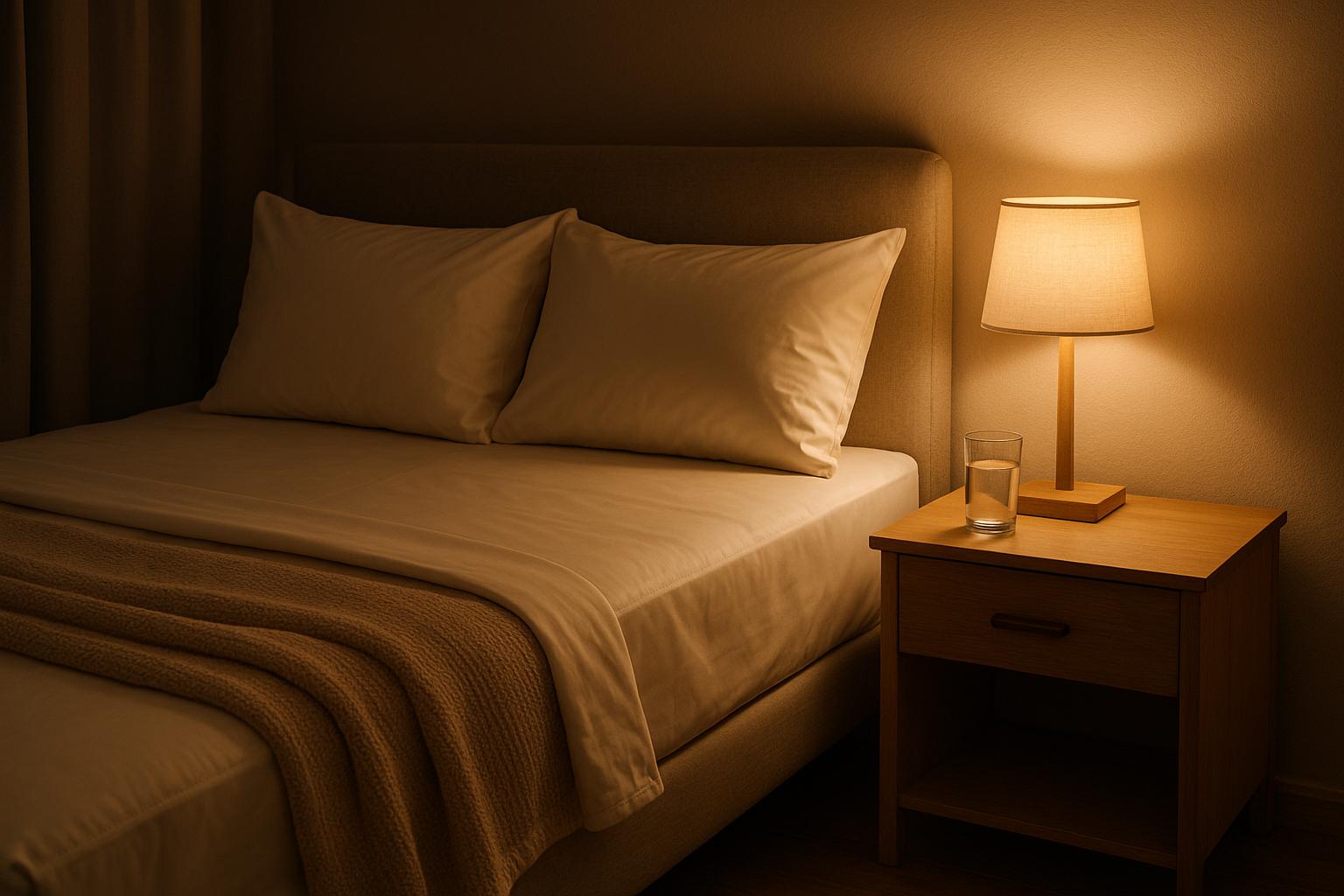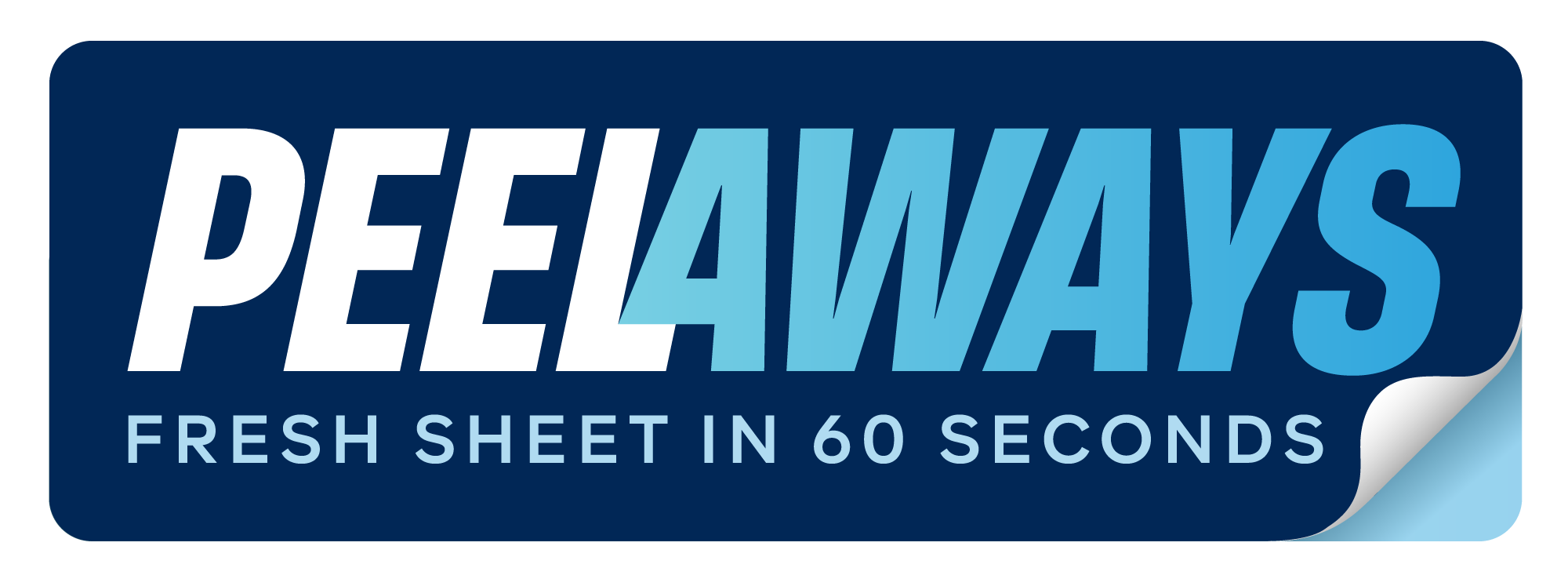7 Essential Tips for Nighttime Incontinence Care

Managing nighttime incontinence can feel overwhelming, but with the right strategies, you can improve comfort, hygiene, and sleep quality. Here's a quick breakdown of effective tips to make nighttime care easier for both individuals and caregivers:
- Protect Your Mattress: Use multi-layer waterproof bedding to prevent damage and simplify cleanups. Disposable sheets are a great option for quick changes.
- Choose High-Absorbency Products: Select briefs, pads, or underpads based on the level of incontinence. Look for features like moisture-wicking and odor control.
- Stick to a Routine: Regulate fluid intake, avoid bladder irritants, and practice double-voiding before bed. Consistency can improve bladder control over time.
- Prioritize Skin Health: Clean, dry, and protect the skin to prevent irritation or infections. Use barrier creams and inspect the skin regularly.
- Maintain Dignity: Use respectful language, offer choices, and ensure privacy during care to support emotional well-being.
- Plan for Easy Cleanups: Keep a bedside kit with essentials like gloves, wipes, and disposable sheets for quick responses to accidents.
- Track and Adjust: Use a bladder diary or technology to monitor patterns and refine your care approach as needs change.
These steps can reduce stress, protect dignity, and ensure restful nights for everyone involved.
8 TIPS to stop FREQUENT URINATION AT NIGHT | Nocturia (2021)
1. Use Multi-Layer Waterproof Bedding Protection
Protecting your mattress is a key part of effective nighttime care. Without proper waterproof bedding, even small accidents can lead to costly mattress damage, persistent odors, or even mold growth [3]. A multi-layer approach works best to handle both routine issues and unexpected incidents during the night.
A good system includes a zippered encasement, a fitted waterproof protector, and washable or disposable bed pads. Together, these layers help absorb moisture, prevent leaks from reaching your mattress, and ensure better hygiene [3].
Make sure to choose sheets that fit snugly to your mattress to avoid shifting. Modern waterproof bedding is designed to be soft, breathable, and quiet, so it remains comfortable and discreet [2].
Why Multi-Layer Disposable Sheets Are Handy
Multi-layer disposable sheets are especially useful for managing nighttime incontinence. They’re convenient, hygienic, and save you from late-night laundry emergencies [3].
These sheets are completely waterproof and made with soft, breathable fabric. Available in 3-, 5-, or 7-layer options, they let you quickly peel away the soiled top layer for a clean surface. This feature is a game-changer when dealing with accidents, as it eliminates the need to strip and remake the entire bed.
Waterproof sheets also protect your mattress from dust, stains, and odors that can build up over time [2]. Dust, in particular, can worsen allergies and respiratory issues [2].
To maintain hygiene, air out bedding for 15–20 minutes each morning to reduce moisture and bacteria [3]. When cleaning is necessary, stick to gentle, unscented cleaners to avoid damaging the waterproof layers or leaving behind harsh residues [3].
Comparing Disposable Sheets and Traditional Waterproof Covers
Choosing between disposable sheets and traditional waterproof covers depends on your specific needs, budget, and preferences. Here’s a quick breakdown of the differences:
| Feature | Multi-Layer Disposable Sheets | Traditional Waterproof Covers |
|---|---|---|
| Convenience | Remove soiled layers instantly - no bed stripping needed | Requires full removal and washing |
| Hygiene | Fresh, clean surface with each layer | Must be thoroughly cleaned between uses |
| Setup Time | Quick and easy - layers peel off in seconds | Involves stripping and remaking the bed |
| Laundry | Minimal - only bottom bedding needs regular washing | Frequent washing of covers required |
| Cost | Higher per-use cost but saves on cleaning time and supplies | Lower upfront cost but ongoing detergent and utility expenses |
| Travel | Lightweight and portable - great for trips | Bulky and less convenient for travel |
| Durability | Single-use layers with backups readily available | Reusable but may lose waterproofing over time |
Traditional waterproof covers are valued for their durability and reusability. Many people appreciate their absorbency and washability, though some note that they may lose effectiveness over time or shift during use. Vinyl protectors, while sturdy, can be noisy or trap heat, whereas polyurethane options offer better breathability and comfort.
If you’re dealing with frequent accidents or caring for someone with advanced incontinence, the ease and hygiene of disposable sheets often justify the higher cost. For occasional use or a tighter budget, washable covers may be the better choice. Either way, pairing mattress protection with high-absorbency products ensures a more comfortable and worry-free night.
2. Choose High-Absorbency Nighttime Products
Products designed for extended wear - up to 12 hours - help keep skin dry and minimize irritation [7]. For individuals managing adult incontinence, using the right product can make all the difference. Studies show that nearly 80% of people in this group may be using products that don't fully meet their needs [8], leading to leaks, discomfort, and added stress at night.
When selecting a product, consider your specific needs and mobility:
- Adult Briefs: These are perfect for moderate to heavy incontinence. They provide high absorbency, quick-change features, and reliable overnight protection, even for bowel incontinence. They’re especially helpful for individuals with limited mobility.
- Pads: Best suited for light to moderate urinary leakage, pads attach discreetly to regular underwear. However, they may not offer enough protection for heavier leakage during the night.
- Underpads: These provide extra protection for bedding and furniture. They work well for bedridden individuals or as a supplement to other high-absorbency products.
What to Look for in High-Absorbency Products
When choosing a product, focus on these key features:
- Absorbency Capacity: Look for products with super absorbent polymers that effectively lock in moisture. For instance, Tranquility ATN (All Through the Night) Disposable Briefs can hold up to 1 liter of liquid [5].
- Quick-Absorption Technology: Products should wick moisture away from the skin quickly to maintain dryness. For example, Tena Stylish Super Plus Heavy Underwear for Women absorbed 38 ounces (4.75 cups) of water during testing while remaining mostly dry on the surface [6].
- Material and Comfort: Opt for briefs with cloth-like outer layers, moisture-wicking interiors, and breathable fabrics. Many modern designs incorporate advanced features like Instadry technology, ConfioAir Fully Breathable technology, or MaxSorb Gel technology for added comfort and performance.
- Proper Fit: A well-fitting product is essential to prevent leaks and ensure comfort. Measure key areas like waist, hips, and thighs, and take advantage of sample programs from manufacturers to find the best size.
- Additional Features: Look for options with odor control, wetness indicators, and designs tailored for lie-down protection to enhance nighttime performance and maintain dignity.
"Modern incontinence supplies are thoughtfully designed with a lot of technology and engineering for form, fit, and function." – ABC Medical [4]
For light to moderate leakage, washable fabric options can be a cost-effective choice. However, disposable products are usually better for managing heavy incontinence or ensuring overnight hygiene and security.
Always check the manufacturer’s specifications before making a purchase. High-quality nighttime products can improve sleep, protect skin health, and ease stress for both caregivers and those managing incontinence.
"A comfortable, reliable pair of incontinence underwear can give you the confidence and peace of mind to go about your day without worrying about leaks or the discomfort of dampness." – NYT Wirecutter [6]
Combining the right absorbency product with effective bedding protection ensures a restful, worry-free night for everyone involved.
3. Create a Consistent Nighttime Routine
A steady bedtime routine can make a big difference in managing nighttime incontinence while also improving sleep quality. Pairing this routine with protective bedding and the right products helps promote better bladder control. By sticking to regular habits around fluid intake, bathroom visits, and sleep preparation, you can support your body’s natural rhythms.
Managing Fluid Intake
One of the most effective steps is to regulate your fluid consumption. Try to limit liquids after 5:00 p.m., and steer clear of common bladder irritants in the evening. These include caffeine, alcohol, citrus juices, cranberry juice, spicy or acidic foods, chocolate, and artificial sweeteners [10]. During the day, stay hydrated but aim to shift most of your liquid intake to earlier hours.
Another helpful tip is double-voiding. After your usual bathroom visit, go through the rest of your bedtime routine - like brushing your teeth, washing your face, and putting on pajamas - then make a second trip to the bathroom. Even if you don’t feel a strong urge, this extra step can help ensure your bladder is fully emptied [10].
Steps for a Better Bedtime Routine
Use these fluid management strategies to build a structured nighttime routine. Start at the same time every evening so your body gets used to the pattern. Scheduled bathroom trips can also help improve bladder control over time. If you’re working on bladder training, track your usual bathroom intervals and gradually extend them. For example, if you typically go every hour, aim for every hour and 20 minutes [11].
Creating a well-prepared environment is equally important. Consider adding motion sensor lights to provide a clear path to the bathroom for safer and easier nighttime visits [12].
For extra support, incontinence alarms can be a useful tool. These devices, which attach to underwear, pads, or bedding, detect moisture and gently wake you if needed [13]. Pairing these alarms with bladder training techniques - like timed voiding and distraction methods - can gradually improve bladder control and reduce urgency. Keeping a bladder diary to monitor your habits and progress can help you fine-tune your routine over time [13].
4. Maintain Skin Health and Hygiene
Taking care of your skin is a must when managing nighttime incontinence. Excess moisture can lead to incontinence-associated dermatitis (IAD), a condition that affects up to 50% of individuals dealing with incontinence[15]. The numbers are telling: IAD occurs in about 6% of hospital patients, 17% of nursing home residents, and 20% of those receiving care at home[15]. Cleaning the skin promptly after an incontinence episode is key to avoiding skin breakdown.
It's important to note that IAD is different from pressure ulcers. While IAD is caused by moisture affecting the skin's surface layers, pressure ulcers result from prolonged pressure and impact deeper tissues[15].
Skin Care Best Practices
To keep skin healthy, follow these tips:
-
Gentle Cleansing: Use a mild, soap-free cleanser and avoid scrubbing, which can irritate the skin. According to the National Association for Continence:
"Special cleansers which remove urine and stool without the need for scrubbing and which are not drying to the skin, no matter how often they are used each day, are important to people with incontinence." [14]
- Thorough Drying: After cleansing, pat the skin dry with a soft towel. For areas that stay damp, consider air drying or using a cool hairdryer.
- Moisturizing and Protection: Once the skin is dry, apply a moisturizer free of alcohol to prevent dryness or irritation. Follow up with a barrier cream containing zinc oxide, lanolin, or petrolatum to shield the skin from further moisture exposure.
- Daily Skin Checks: Regularly inspect the skin, especially for those with limited mobility. Look for redness, blisters, or irritation, and address any issues quickly.
- Treating Yeast Infections: If you notice persistent redness or a raised rash, it could be a yeast infection. Use an antifungal powder with ingredients like nystatin or miconazole. Avoid baby powder, as it lacks antifungal properties.
If skin issues persist despite diligent care, it’s essential to contact a healthcare provider. Early medical attention can prevent complications and ensure the skin gets the proper treatment it needs.
Sticking to a consistent routine of cleaning, drying, and protecting the skin after each incontinence episode is crucial. Healthy, well-cared-for skin not only prevents complications but also plays a big role in maintaining comfort and dignity during nighttime care.
sbb-itb-45288fe
5. Keep Comfort and Dignity During Nighttime Care
Caring for someone managing nighttime incontinence is about much more than just addressing physical needs. It's equally about respecting their dignity and preserving their sense of self-worth. As Marie Curie points out:
"Incontinence can be embarrassing and it's important to help people keep their dignity" [16].
The emotional toll of requiring assistance can often rival the physical challenges. Creating a judgment-free environment not only helps maintain dignity but also fosters a sense of independence and bolsters self-esteem.
Practical Steps for Comfort and Dignity
While physical care and hygiene are essential, prioritizing dignity completes the picture of compassionate care. Here’s how you can approach it:
- Use respectful language. For instance, say "changing" instead of "accident" to avoid embarrassment or shame.
- Ensure privacy. Close bedroom doors, use soft, calming lighting, and store incontinence supplies discreetly but accessibly. Multi-layer disposable sheets can also minimize disruptions and preserve privacy during bedding changes.
- Offer choices to empower autonomy. Simple questions like, "Would you like to change first, or should we adjust the bedding?" or "Do you need an extra blanket?" can help the individual feel more in control of their care.
- Respond promptly and calmly. Quick responses to requests for help not only prevent discomfort but also communicate that their needs are a priority. A calm and reassuring demeanor can further ease any distress.
- Focus on solutions, not setbacks. Keeping care supplies organized and easily accessible can simplify the process and reduce stress for everyone involved.
- Acknowledge their feelings. A kind word like, "I know this isn’t easy", or "You’re managing this so well", can go a long way in offering emotional support. The National Association for Continence highlights the importance of compassion in care:
"At the core of incontinence care is a deep sense of compassion - treating your loved one not as a patient, but as a person who deserves respect, comfort, and the best quality of life possible" [17].
- Encourage independence where possible. Allowing them to participate in simple tasks, like choosing their nighttime clothing or assisting with care routines, helps maintain a sense of capability and self-reliance.
6. Plan for Quick and Easy Cleanups
Dealing with nighttime incontinence calls for quick and efficient cleanups to minimize disruptions. No one wants to spend precious nighttime hours stripping beds and remaking them. The goal is to restore comfort and cleanliness as fast as possible so everyone can get back to sleep. Smart organization and the right tools make these cleanups much easier.
Instead of the traditional approach of washing linens and remaking the bed, consider using multi-layer disposable sheets. These allow for a hassle-free cleanup by simply peeling away a soiled layer, keeping the mattress protected and cutting down on time and effort.
"I could see the Peelaways being especially useful at night when the caregiver is tired and just needs to make it to the next day." – Chris Clark, AgingToday.com [18]
Organizing Supplies for Efficiency
Preparation is key to handling nighttime accidents smoothly. A well-organized bedside cleanup kit can turn unexpected situations into manageable ones. Include essentials like:
- Disposable gloves for hygiene
- Gentle cleansing wipes for skin care
- Disposal bags for soiled items
- A small flashlight or battery-operated lamp for visibility in low light
Store these items in a portable caddy or basket that’s easy to grab and accessible from either side of the bed. Pre-layer the bed with PeelAways disposable sheets, so you’re always ready to peel off a used layer and reveal a clean one underneath.
"My parents can change their sheet in the middle of the night on their own without any aid and go back to bed. If the children spill something or have a little accident, or don't feel well. They can be picked up, peel off the sheet, they are still asleep, and put back down." – Carol Suchman, Creator of Peelaways [18]
Keep the cleanup kit on the caregiver’s side of the bed for quick access. A bedside table with compartments or drawers can help keep everything organized and within reach.
Training all caregivers on how to properly use multi-layer sheets ensures consistency and smooth handling. Make sure everyone knows how to peel away layers correctly, dispose of soiled materials, and check the condition of remaining layers [19]. Regularly inspecting the top layer and removing any that are worn or damp helps maintain a clean, dry sleeping surface [19].
Using hypoallergenic disposable sheets also reduces the risk of skin irritation, which is especially beneficial during nighttime care when thorough skin checks might be harder to perform [19]. These small steps can make nighttime care much less stressful for everyone involved.
7. Monitor and Adjust Your Care Approach
Caring for nighttime incontinence is not a one-size-fits-all situation - it requires ongoing tweaks as circumstances evolve. Keeping track of patterns and being flexible with your care approach can help reduce stress and improve outcomes.
One useful tool is a bladder diary. Over three to seven days, jot down details like the time and amount of fluid consumed, bathroom visits, leakage incidents, and any pre-leak sensations [20]. For instance, you might note drinking 8 oz of water at 7:00 PM, a bathroom trip at 10:30 PM, or a leakage episode at 2:15 AM. This kind of detailed record gives healthcare providers the data they need to refine your care plan. Use these insights to adjust your routines and make more informed decisions.
Technology can also be a game-changer. Apps that track fluid intake and output or guide pelvic floor exercises can simplify monitoring [21]. Smart systems, like care bed monitors that provide real-time leakage alerts, offer another layer of support [22]. While smart diapers come with a steep price - installation costs can reach $3,300, and each unit may cost up to $3.50 [22] - their immediate feedback can be incredibly helpful for managing care.
Simple adjustments can make a big difference. Try limiting fluids in the evening, setting a pre-bedtime bathroom reminder [9], or incorporating bladder training and pelvic floor exercises. A continence assessment can provide a more personalized plan, taking into account factors like medical history, fluid intake, medications, and self-care abilities [1].
Don't overlook the environment. Adding grab bars, using raised toilet seats, or creating a calming toileting space can enhance safety and comfort, especially as mobility or cognitive abilities shift over time [1].
Finally, remember that incontinence patterns can change due to medications, illness, or stress. Regular check-ins with your healthcare provider ensure your care plan stays effective [20]. Stay alert to changes and adjust your approach as needed to meet evolving needs.
Conclusion: Better Nighttime Care with Simple Solutions
Handling nighttime incontinence doesn’t have to feel like an uphill battle. By combining these seven straightforward tips, you can create a care plan that emphasizes comfort, cleanliness, and respect. Start with essentials like waterproof bedding, high-absorbency products, and a consistent routine to set the foundation for effective care.
Each step, no matter how small, contributes to easing stress and protecting dignity. Prioritizing skin care and hygiene is crucial, while ensuring comfort and respect helps nurture emotional well-being. Keeping supplies organized for quick cleanups can make nighttime incidents less disruptive, and staying flexible allows you to adjust as needs evolve.
With patience and consistency, you can build a supportive environment where accidents are handled calmly, dignity is upheld, and everyone gets the restful sleep they deserve.
FAQs
What are the best ways to manage nighttime incontinence while preserving the dignity of the person in your care?
Managing nighttime incontinence requires a thoughtful approach that prioritizes the individual's comfort and dignity. A supportive environment can make a significant difference, and involving the person in care decisions helps them feel respected and valued.
Invest in reliable incontinence products, like absorbent pads or overnight briefs, to ensure they stay dry and comfortable through the night. Additionally, setting up a steady nighttime routine - such as reducing fluid intake before bed and making the bathroom easily accessible - can minimize accidents and ease anxiety.
Discreet and compassionate hygiene care is essential, as it not only promotes physical comfort but also helps maintain their sense of self-worth.
What’s the difference between multi-layer disposable sheets and traditional waterproof mattress covers for nighttime incontinence?
Multi-layer disposable sheets, such as PeelAways, are built with several waterproof layers, making them easy to remove and replace after use. This design ensures strong leak protection while also promoting better hygiene. Since they're single-use, they’re particularly handy for caregivers who need a quick, no-fuss solution.
In contrast, traditional waterproof mattress covers are reusable and crafted from sturdy materials meant to offer long-term protection for mattresses. While they do a good job of preventing damage, they don’t feature the multi-layer design and might not handle heavy leaks as effectively.
The main difference boils down to their focus: disposable sheets emphasize convenience and cleanliness, whereas traditional covers are all about durability and repeated use. The best choice comes down to specific care requirements and personal preferences.
How can using technology and a bladder diary improve nighttime incontinence care?
Tracking nighttime incontinence has become easier thanks to technology and digital bladder diaries. These tools help caregivers log essential details such as fluid intake, bathroom visits, and leakage episodes, offering a clear picture of urinary patterns and potential triggers.
Some cutting-edge devices, like automated bladder monitors, take it a step further by collecting real-time data. This level of accuracy allows for more tailored care approaches. By leveraging these tools, caregivers can minimize nighttime disruptions, improve hygiene, and enhance overall comfort for those they care for.
Related posts
Comments
0

SAVE MONEY & WATER
Professionals & Institutions save a fortune on labor/laundry.

SUPERIOR COMFORT
The first thing our customers notice is how soft our sheets are.

100% WATERPROOF
Each layer is 100% Waterproof, perfect for spills and accidents

SAVE TIME
Change the sheet in under 1 minute without stripping the bed.




Leave a comment